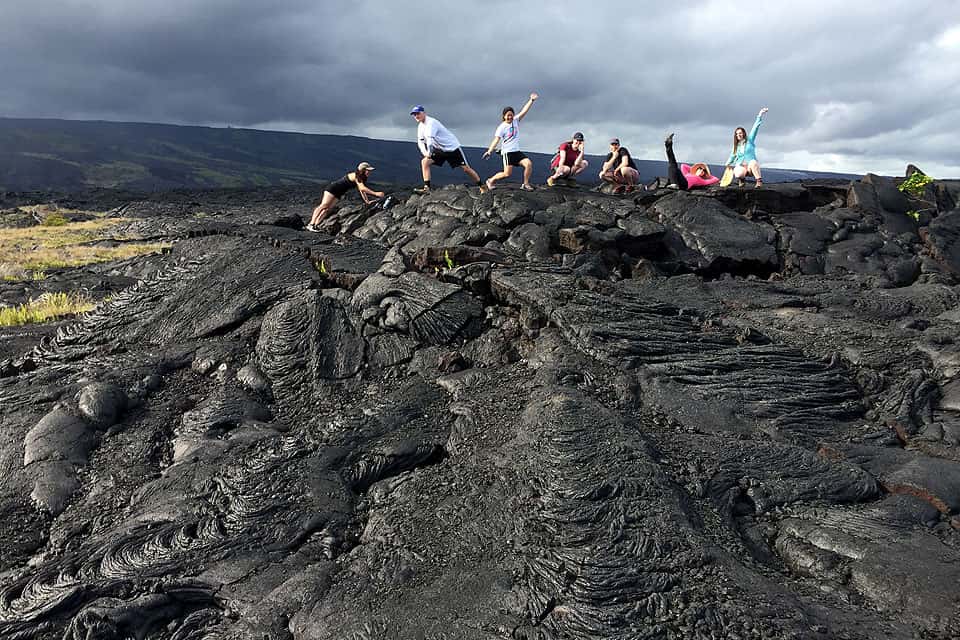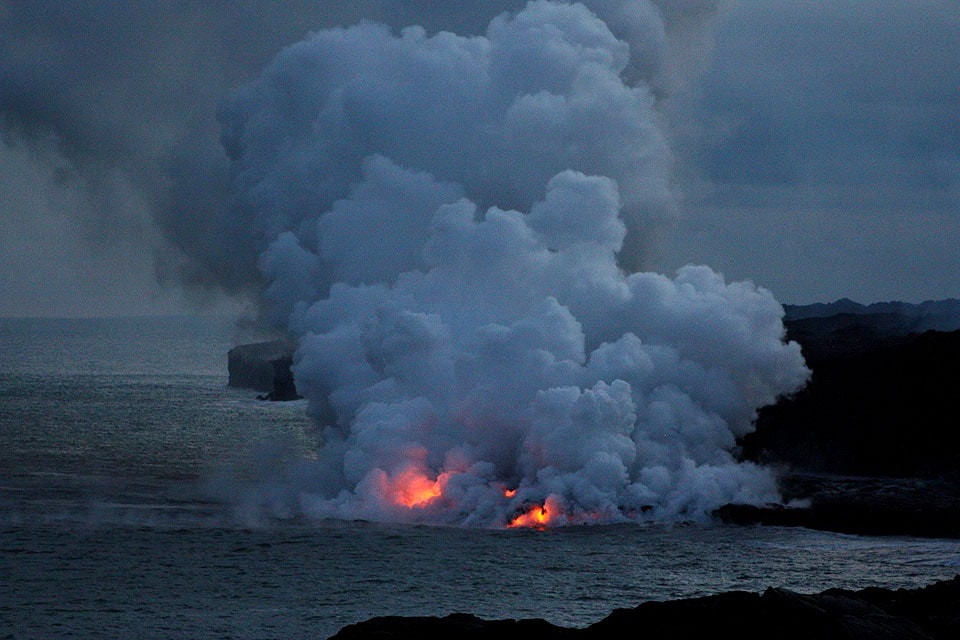Learning in Lava Fields: Students Experience the Geosciences Through SLU Trips
In May, graduate student Kayla Lockmiller hiked four miles to see the youngest earth on the planet being formed in Hawai'i Volcanoes National Park.
Part of the annual Geosciences Trip in the Department of Earth and Atmospheric Sciences, Lockmiller and her fellow students, from freshmen to doctoral, are part of a department tradition that takes teaching beyond the classroom and exposes students to learning in the field and from one another.
"I don't think I'll be lucky enough to see anything like that again," Lockmiller said. "This hands-on type of learning really brings the topics learned in classrooms to life." That is exactly what the Department of Earth and Atmospheric Sciences (EAS) and trip leader John Encarnacion, Ph.D., have in mind with the annual trips that take students to locations like Hawaii, Puerto Rico, Georgia, Tennessee and California.
"EAS strives to give our students a strong field-based education in environmental sciences, environmental studies and geology," Encarnacion said. "Lab classes and PowerPoints at the University can only do so much for student learning. You might have a piece of deformed rock but you go out and see it as part of the mountain ... [Students] see how it's part of the whole landscape."
Field work is a critical piece in helping students make the real-world connections to the geology and environmental science they learn at SLU, Encarnacion explained.
"To be a geologist," Encarnacion said, "is to be in the field."
In order to provide that opportunity to students from a host of backgrounds, the department utilizes an endowment to keep the costs associated with the trips down. It also allows a donor's generosity to positively impact more students, he said. This year, the Macelwane-Blum Endowment and the department itself supported 75 percent of the trip's costs.
May's trip took 35 students, faculty and staff members to the island of Hawai'i, the largest of the islands making up the state. The trip's itinerary found the SLU group hiking miles through lava fields, meeting with staff members at Hawai'i Volcanoes National Park and the Hawaii Volcanoes Observatory, exploring a green sand beach and visiting sea turtle sanctuary.
I think it (Geosciences Trip) speaks volumes as to how much the faculty and staff really care about students learning from such unique experiences."
Kayla Lockmiller, graduate student
"The most unexpected thing that I've discovered from trips like Hawaii is how much you actually learn from them," Lockmiller explained. "A lot of people think we just go on these trips for a vacation, but a lot of learning happens in the process. Being able to see geologic processes physically happening is so unique and so crucial to really understanding them."
Part of being in the field, Encarnacion said, is learning how to work with other professionals and scientists and to form learning communities. For alumna Camille Buckley (A&S '17), the department trips have been "opportunities to pick not only the brains of your teachers but also those of your classmates and friends."
"These trips were extremely important to my education and future plans," Buckley said. "It's very different learning about something in the classroom and then actually understanding how it works in real life situations."
Tapping a Well of Knowledge
Buckley's time on the trips led her to switch majors to her eventual degree in environmental science and to work she undertook as a lab assistant with EAS faculty member, Elizabeth Hasenmueller in hydrology and geochemistry.
Getting to know Hasenmueller and other EAS faculty members on trips, including the Hawaii expedition this May, added to Buckley's education in ways she didn't foresee.
"I discovered she was an endless well of knowledge," Buckley recalled. "The trips have highly influenced my decisions throughout school for the better and I'm grateful to the faculty and teachers that make them possible."
Lockmiller, a second-year student in the department's master of science program, echoed Buckley, citing the trip as critical to her continuing study in environmental geoscience.
While her own research interests don't involve the study of volcanoes like Mauna Loa or Kilauea, Lockmiller said learning from experts at the United States Geological Survey and from her SLU faculty members and fellow students through the Hawaii trip - her first as a Billiken - has pushed her to grow as a scientist.
"I'm drawn to the geosciences because of the complexity of the problems that we try to solve," Lockmiller said. "It's almost like a puzzle; we collect samples, data and observations and try to piece them together to tell a cohesive story. There are so many unanswered questions in geoscience and I think it's exciting that there is always more to learn. "
"I chose to go on the department's trip to Hawaii because I was interested in seeing the unique geology there," she continued. "Visiting an active volcano is definitely a once-in-lifetime opportunity.
"In terms of my SLU experience, I was shocked that the department could take 32 students to somewhere so far away. I think it speaks volumes as to how much the faculty and staff really care about students learning from such unique experiences."
Learning in the Classroom and the Field
The Department of Earth and Atmospheric Sciences in SLU's College of Arts and Sciences has a tradition of combining strong classroom and field-based instruction with internationally recognized research across a broad spectrum of the physical sciences, including seismology and solid earth geophysics, tectonics, synoptic meteorology, environmental systems and the study of modern and ancient climate change.
The department is the result of a rich heritage that includes the first geophysics department in the Western Hemisphere, and as such, offers a wide range of undergraduate and graduate degree programs. These programs include traditional, internationally recognized doctoral programs as well as innovative new undergraduate programs that provide unique, campus-wide learning experiences.
The department's research centers include the Earthquake Center, the Cooperative Institute for Precipitation Systems, the Global Geodynamics Program, the Center for Environmental Sciences and Quantum WeatherTM.
The fusion of academic programs with world-class research provides SLU students with an unparalleled opportunity to explore their interests and prepare for a wide variety of careers after graduation.
Story by Amelia Flood, University Marketing and Communications.
Photos courtesy of John Encarnacion, Ph.D.



















